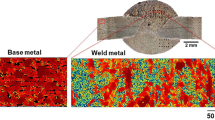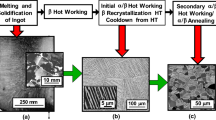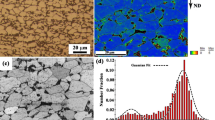Abstract
Characteristics of mechanical resonance are measured on powder iron samples with a porosity of 0.06 produced by die compaction and sintering at 573 to 1373 K. Young’s modulus and parameter CN that describes how the resonant frequency varies with increasing amplitude of oscillation are calculated. It is established that CN decreases with increasing temperature of sintering. Comparing the resonance characteristics with results from fracture toughness tests and structural analysis shows that CN correlates with fracture toughness and failure mode of samples. The results indicate that CN is related to the evolution of the interparticle boundaries and may be used as a highly sensitive criterion to quantitatively assess the quality of sintered powder materials.
Similar content being viewed by others
References
F. B. Swinkels and M. F. Ashby, “A second report on sintering diagrams,” Acta Metall., 29, 259–281 (1981).
V. V. Skorokhod, Rheological Basis of Sintering Theory [in Russian], Naukova Dumka, Kiev (1972), p. 151.
E. A. Olevsky, “Theory of sintering: from discrete to continuum,” Mater. Sci. Eng. R., 23, 41–100 (1998).
A. V. Vdovichenko and Yu. N. Podrezov, “Evolution of dynamic Young’s modulus and damping ability of porous iron,” Metallofiz. Noveish. Tekhnol., 27, No. 11, 1429–1440 (2005).
O. V. Roman, V. V. Skorokhod, and G. R. Fridman, Ultrasonic and Resistometric Inspection in Powder Metallurgy [in Russian], Vysshaya Shkola, Minsk (1989), p. 182.
L. D. Landau and E. M. Lifshits, Theoretical Physics. Vol. VII: Elasticity Theory [in Russian], Nauka, Moscow (1987), p. 248.
A. S. Drachinskii, A. E. Kushevskii, and Yu. N. Podrezov, “Effect of the scale factor on the results of determinations of the mechanical properties of iron-base P/M materials,” Powder Metall. Met. Ceram., 22, No. 3, 233–237 (1983).
V. A. Kuz’menko (ed.), Fatigue Tests at High Loading Frequencies [in Russian], Naukova Dumka, Kiev (1979), p. 336.
A. V. Vdovichenko, Yu. F. Lugovskii, and V. A. Nazarenko, “Fatigue failure of rolled high-porosity materials made of copper fiber at resonance bending oscillations,” Powder Metall. Met. Ceram., 30, No. 1, 87–89 (1991).
O. V. Vdovichenko, V. V. Skorokhod, and M. B. Shtern, “Modeling elastic oscillations of rods from powder materials in the presence of 2D defects,” in: Mathematical Models and Computational Experiment in Materials Science, Issue 9, Inst. Probl. Materialoved. NANU, Kiev (2007), pp. 3–7.
S. A. Firstov and M. Shlesar (ed.), Structure and Strength of Powder Materials [in Russian], Naukova Dumka, Kiev (1993), p. 174.
Author information
Authors and Affiliations
Corresponding author
Additional information
__________
Translated from Poroshkovaya Metallurgiya, Vol. 47, No. 5–6 (461), pp. 128–137, 2008.
Rights and permissions
About this article
Cite this article
Vdovichenko, A.V., Podrezov, Y.N. & Skorokhod, V.V. Mechanical resonance spectroscopy of interparticle boundaries in high-density iron powder compacts. Powder Metall Met Ceram 47, 366–372 (2008). https://doi.org/10.1007/s11106-008-9028-0
Received:
Published:
Issue Date:
DOI: https://doi.org/10.1007/s11106-008-9028-0




